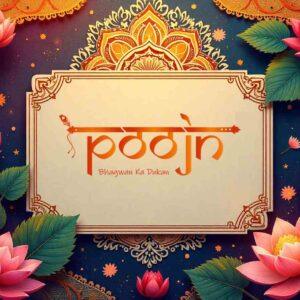

In every Indian home, there’s a special feeling that fills the air during a puja. It’s a mix of fragrant incense, the sound of ringing bells, and the delicious aroma of something special being cooked in the kitchen. That special food, prepared with so much love and devotion, is Prasad. It’s more than just a meal; it’s a sacred offering, a piece of divine blessing that we share with our loved ones, strengthening our bonds of community and faith.
The beauty of prasad is how it connects us all, reflecting the incredible diversity of our culture. And today, even with our busy lives, technology helps us keep these traditions alive, making it easier than ever to find authentic ingredients for our sacred rituals.
What is the True Essence of Prasad?
Prasad, a word from Sanskrit, beautifully translates to ‘a gracious gift’ or ‘divine favour’. It’s the food that we first offer to God with a pure heart. Once the deity has ‘accepted’ it, the food becomes blessed. This blessed food, or prasad, is believed to carry divine energy, purifying the mind and soul of anyone who consumes it.
Sharing this sacred offering is a vital part of our worship. When prasad is distributed among family, friends, and devotees, it’s not just food being shared; it’s a moment of collective blessing and unity. From the simplest Nakuldana to elaborate sweets, every offering tells a story of devotion.
A Culinary Journey: Prasad Across India
India’s cultural landscape is vast, and so are its prasad traditions. Each region has its unique way of showing reverence through food.
- In North India, especially in Gurdwaras, the warmth of Kada Prasad touches every soul. This simple halwa made of wheat flour, ghee, and sugar is a humbling experience of equality and devotion. Another beloved offering is Panjiri, a nutty, wholesome mix often prepared during festivals.
- Travel to South India, and you’ll be greeted with the delightful aroma of Sakkarai Pongal (Sweet Pongal). Made with freshly harvested rice, jaggery, and ghee, this dish is a staple during Pongal and other temple festivals, celebrating nature’s bounty.
- In Maharashtra, no Ganesh Chaturthi is complete without Modak. These sweet, steamed dumplings filled with coconut and jaggery are considered Lord Ganesha’s favourite, and making them is a cherished family ritual.
- In Bengal, offerings often include simple yet profound items like Khoi with jaggery or the famous Tal Michri, showcasing a deep connection to local ingredients and traditions.
The Soul of the Offering: Why Ingredients Matter
The ingredients used in prasad are chosen with great care, as each one holds a special meaning. Ghee (clarified butter) represents purity, sugar and jaggery signify the sweetness of life and devotion, while milk stands for nourishment and abundance. Spices like cardamom and saffron not only add flavour but are also symbols of auspiciousness. Using fresh, high-quality ingredients is a way of offering our very best to the divine, reflecting the sincerity of our prayers, which are often guided by powerful Sanskrit Mantras.
Authentic Prasad Recipes for Your Puja
Here are some cherished prasad recipes you can easily prepare at home to make your puja truly special.
- Kada Prasad: A soul-stirring offering, this halwa is made with equal parts whole wheat flour, ghee, and sugar, with about three parts water. The key is to roast the flour in ghee until it turns a deep golden brown and fills the air with a nutty fragrance, before adding the sugar syrup. It’s a taste of pure bliss.
- Charnamrit (Panchamrit): This sacred elixir is made with five nectars: milk, curd (yoghurt), honey, ghee, and sugar, often with a few Tulsi leaves. It symbolises a divine blend of elements and is a must-have in many pujas for purification and blessings.
- Sweet Pongal (Sakkarai Pongal): A comforting delicacy from South India that warms the heart. Rice and moong dal are cooked until soft and then sweetened with jaggery, enriched with ghee, and flavoured with cardamom and edible camphor. Garnished with fried cashews and raisins, it’s a festive treat.
- Rava Sheera (Suji Halwa): A popular and quick pudding made with semolina (rava/suji). The semolina is roasted in ghee until fragrant, then cooked with sugar and water or milk. A pinch of cardamom and a garnish of nuts make it a perfect offering for any occasion.
- Coconut Ladoo or Barfi: A simple yet divine sweet made with desiccated coconut and condensed milk or sugar. The mixture is cooked until it thickens and can be shaped into small balls (laddoos) or set into squares (barfi). It’s a quick way to prepare a delicious and heartfelt offering.
Tradition Meets Today: The Convenience of Preparing Prasad
In our fast-paced lives, it can sometimes be challenging to find the time and authentic ingredients to prepare traditional prasad. But technology has brought a wonderful solution. Online stores have made it incredibly easy to access high-quality, pure ingredients needed for our sacred rituals. From the finest ghee and jaggery to special puja items, everything is now just a click away.
This blend of tradition and modern convenience allows us to uphold our sacred practices with the same love and devotion as our ancestors. We can continue to create these beautiful offerings, keeping the spirit of our traditions alive for generations to come.
Enhance Your Puja with Authentic Items from Poojn.in
At poojn.in, we understand the heart of these traditions. That’s why we bring you a wide range of authentic puja items and ingredients, ensuring your offerings are pure and meaningful. Whether you need pure Tal Michri (Palm Candy) or a beautiful Akhand Diya, we are here to support your spiritual journey.
Why choose Poojn.in for your needs? We are committed to quality, authenticity, and convenience. We ensure our products are sourced traditionally and handled with the respect they deserve, so you can perform your rituals with peace of mind. For any assistance, feel free to visit our website or contact us at 03369029784 or WhatsApp at 9476142738.
Answering Your Heartfelt Questions about Prasad
The Importance of Prasad in Puja
Many wonder why prasad is so central to our worship. It’s because prasad signifies the deep, personal connection between a devotee and the divine. It is a physical manifestation of God’s blessings, making the divine accessible and tangible to us.
Preparing the Offering with Purity
A common thought is how prasad should be prepared. The key is to maintain both physical and mental purity. It should be cooked in a clean kitchen with a calm and prayerful state of mind. Traditionally, the food is not tasted while cooking, as it is meant to be offered to the deity first, a practice that teaches discipline and selflessness.
The Right Moment to Offer Prasad
Prasad is typically offered towards the end of the puja, during the main rituals or aarti. This is considered the peak moment of the ceremony when the connection with the divine is strongest. After the offering, it is shared with everyone as a token of that divine connection.
Can Prasad Be Purchased?
Absolutely. While making prasad at home is a beautiful act of devotion, our busy lives sometimes make it difficult. In such cases, purchasing prasad from a trusted source is perfectly acceptable. The sincerity and devotion in your heart are what truly matter. Many online stores now provide authentic, traditionally prepared prasad, ensuring you can complete your rituals with reverence.
Embrace Tradition with an Open Heart
Prasad is more than just food; it’s an emotion, a sacred trust, and a celebration of faith. As you prepare and share it, you’re not just following a ritual—you’re nurturing a connection with the divine and with a community that shares these timeless values. Let every offering you make be a heartfelt tribute, blending the wisdom of our ancestors with the convenience of today.


